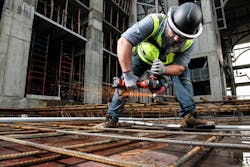Technology powers much of the world around us these days. From basic appliances to sophisticated business software and industrial applications, the internet of things (IoT) makes them all work more efficiently.
Yet construction is still one of the least digitized business sectors in the world, according to the McKinsey Global Institute’s Industry Digitization Index. A study conducted by Trimble Construction also reports that the average construction company spends about 90 hours a week — the equivalent of more than two full-time employees — searching for and tracking the performance of its assets across construction sites.
“There are many issues confronting the industry right now,” says Matt Jackson, Senior Director of Power Tools and Accessories at Hilti North America. “The ongoing labor shortage is a big one, which means time is precious and that level of inefficiency just isn’t cutting it anymore.” Hilti, a forward-thinking construction equipment, software, and solutions company, has been working on a way to address these problems.
An Innovative Approach
The heavy equipment industry already employs IoT technology on its earthmoving machinery to protect workers and manage processes that used to be handled manually. Why not extend that capability to power tools? Hilti hit upon a method to do just that and looked to the one thing that all cordless power tools have in common — batteries.
“By making these batteries smart, they can sync up with the tools they’re used with to report back the performance levels, maintenance status, usage data — and where they are located,” says Jackson. Hilti’s all-on-one battery platform is called Nuron.
The Nuron platform was developed with tool-agnostic 22-volt batteries. These batteries can be used interchangeably on the Hilti Nuron platform, whether light- or heavy-duty, from drill drivers to demolition hammers. The battery design provides a longer run time between charges — as much as twice that of a standard battery.
Asset Management
Hilti data indicates that two-thirds of construction companies have issues keeping track of where their equipment is and how effectively it’s being used. “Underutilized and hoarded equipment costs companies money,” says Jackson. That’s because managing tool crib inventory is traditionally an inefficient, manual process that’s tracked on paper or with spreadsheets.
“Having insight into who’s using your tools and where they are located not only helps ensure you’re getting maximum efficiency from them — it saves you the time and expense of searching for them or even replacing them if they go completely missing,” he adds. Hilti’s ON!Track asset management solution reports equipment's last known location and usage, removing the tedious and often inaccurate manual task of tracking all that data.
Purchasing and maintenance costs for tools can also be problematic. One option for dealing with this issue is a newer concept called “equipment as a service,” or EaaS. This method of managing your equipment expenses parallels SaaS, software as a service, a trend in business software that’s seen significant growth worldwide. Instead of having to buy equipment as a large, upfront capital investment, EaaS allows companies to pay monthly for leasing the equipment. This is not only easier to manage from a budgeting and finance point of view — no hefty capital expenditure outlays or complicated depreciation calculations — but maintenance and replacement costs are generally included in the monthly fee.
This also benefits efficiency. Maintenance with an EaaS plan typically involves quicker turnaround times than with owned equipment, and if replacement tools are needed, they’re more immediately available.
Safety
Damaged or poorly maintained tools can be a major risk factor when it comes to worker safety. Here’s another important statistic: U.S. government agencies report that job site injuries cost construction companies about $11 billion every year and that one in five of all workplace fatalities occurs in the industry. Fortunately, helping to prevent tool-related accidents is another area where smart technology can benefit the construction industry.
For example, the Nuron product line employs tech-enabled active torque control to help remove the risk of tool kickback. Dust removal systems incorporated into the tools’ design reduce the workers’ exposure to inhaling particulate matter. And active vibration reduction technology minimizes user-experienced vibrations leading to more comfortable use. “Failure to address safety concerns can cost you — not only in money, but also in reputation and employee morale,” says Jackson.
Right There in the Battery
Disconnected processes and those requiring manual intervention to maintain, and monitor are expensive, siphoning time and energy away from your core business. Smart technologies, on the other hand, do a lot of that work for you, helping you save money and equipment while reducing risks on the job site. Why not consider a solution that handles all that data tracking, integration, and reporting for you?
It couldn’t be easier. After all, it’s all right there in the battery.
Sponsored by:


